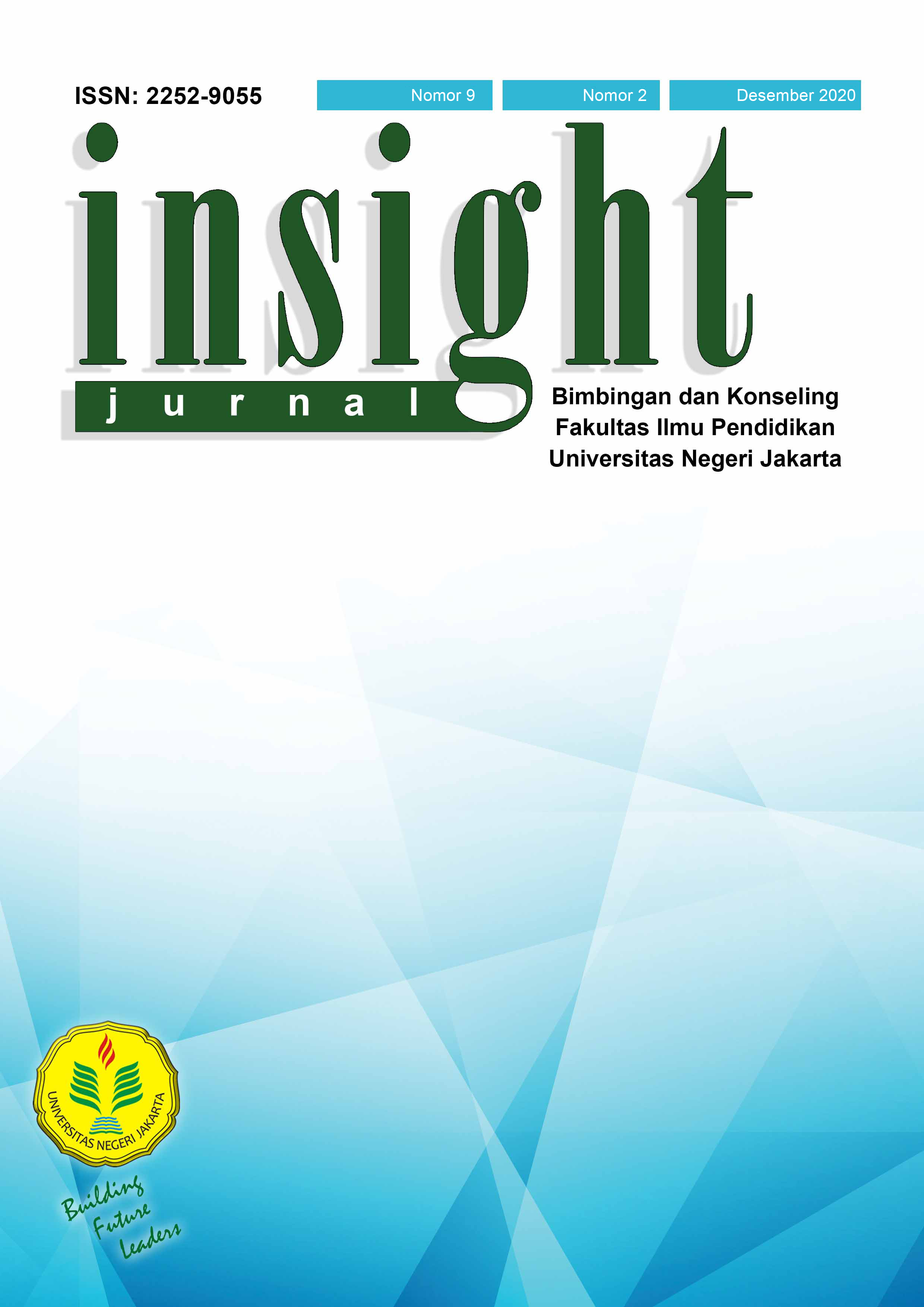Stres Remaja: Kebutuhan Video Mindfulness-Breathing Meditation Untuk Mengurangi Stres Remaja
DOI:
https://doi.org/10.21009/INSIGHT.092.02Keywords:
Stres, Remaja, Mindfulness, Breathing MeditationAbstract
Abstrak
Penelitian ini bertujuan untuk mengetahui tingkat stres remaja dan kebutuhan untuk mengembangkan video tutorial mindfulness-breathing meditation sebagai strategi dalam mengurangi stres remaja. Convenience sampling yang digunakan untuk mengumpulkan data pada 165 peserta didik. Alat ukur yang digunakan adalah perceived stress scale (PSS) dan studi kebutuhan video mindfulness-breathing meditation. Hasil penelitian menunjukkan bahwa tingkat stres remaja yang tinggi (27 dari skor total 40). Perempuan memiliki tingkat stres yang lebih tinggi daripada laki-laki (27,2 vs 26,6), persentase perempuan yang mengalami stres tingkat tinggi lebih banyak daripada laki-laki (54,1%vs 41,3%). Meskipun prevalensi stres sangat tinggi di kalangan remaja, sebagian besar peserta didik sangat minim memiliki paparan materi mengenai cara mengurangi stres (80,15%) serta mengenai latihan bernafas dengan baik. Peserta didik juga sangat antusias untuk mempelajari meditasi pernafasan melalui video (100%). Diketahui juga bahwa pengembangan video mindfulness-breathing meditation sangat penting untuk membantu peserta didik dalam mengurangi stres mereka.
Kata Kunci: Stres, Remaja, Mindfulness, Breathing Meditation
Abstract
This research aims to determine the stress level of adolescents and the need to develop a mindfulness-breathing meditation video as a strategy to reduce adolescents’ stress. The convenience sampling was used to collect data form was 165 students. The measures are the perceived stress scale (PSS) and the needs of mindfulness-breathing meditation video. The results shows that the adolescent’ stress level is high (27 out of 40). Female has higher level stress than male (27,2 vs 26,6), the percentage of female who experience high level stress was outnumber male (54,1% vs 41,3%). Despite the high prevalence of stress among adolescent, most of students has minimum exposure to stress reduction (80,15%) as well as breathing exercises. All students enthusiastic to learn mindfulness-breathing meditation through video. It is recommended that development of mindfulness-breathing meditation video is crucial to help students in reducing their stress.
Keywords: Stress, Adolescent, Mindfulness, Breathing Meditation
References
Aulia, P. (2017). Terapi Kelompok Untuk Mengurangi Stres Anak Didik Pemasyarakatan yang Akan Bebas. Jurnal RAP UNP, 8(1), 69–78.
Azizah. (2013). Kebahagiaan dan Permasalahan di Usia Remaja. Jurnal Bimbingan Konseling Islam, 4(2), 295–316.
Burdick, D. (2013). Mindfulness Skills Workbook For Clinicians & Clients. PESI Publishing and Media.
Burdick, D. E. (2014). Mindfulness Skills for Kids & Teens. In Debra E Burdick. PESI Publishing & Media.
Cohen, S., Kessler, R. C., & Gordon, L. U. (1997). Measuring Stress. Oxford University Press, Inc.
Depkes. (2013). Pokok-Pokokk Hasil Riset Kesehatan Dasar Indonesia. Badan Penelitian dan Pengembangan Kesehatan Kementerian Kesehatan RI.
Erbe, R., & Lohrmann, D. (2015). Mindfulness Meditation for Adolescent Stress and Well-Being : A Systematic Review of the Literature with Implications for School Health Programs. The Health Educator, 47(2), 12–30.
Fitriyani, H., & Rosalia, L. (2018). Pengembangan Media Video Tutorial Untuk Mengenalkan Treatment Mengelola Emosi Marah Pada Peserta Didik Kelas X Di SMK Cipta Karya Jakarta. 7(2), 147–153.
Furqan, A. (2017). Pengaruh Terapi Relaksasi Progresif Terhadap Stres Pada Remaja Penghuni Lembaga Pemasyarakatan Kota Samarinda. Jurnal Psikologi, 5(2), 115–124.
Hapsari, R. D., Putri, A. M., & Fitriani, D. (2019). Hubungan Antara Dukungan Sosial Dengan Tingkat Stres Orang Tua Dengan Anak Penderita Autisme. Jurnal Psikologi, 1(2), 74–84. https://doi.org/10.36269/psyche.v1i2.101
Hidayati, N., & Huriati. (2016). Krisis Identitas Diri Pada Remaja. Jurnal Sulesana, 10(1), 49–62.
Maharani, E. A. (2016). Pengaruh Pelatihan Berbasis Mindfulness Terhadap Tingkat Stres Pada Guru PAUD. Jurnal Penelitian Ilmu Pendidikan, 9(2), 100–110.
Muhid, A., & Mukarromah, A. (2018). Pengaruh Harapan Orang Tua dan Self-Efficacy Akademik Terhadap Kecenderungan Fear Or Failure Pada Siswa: Analisis Perbandingan Antara Siswa Kelas Unggulan dan Siswa Kelas Reguler. 10(1), 31–48. https://doi.org/10.1017/CBO9781107415324.004
Nasrani, L., & Purnawati, S. (2016). Perbedaan Tingkat Stres antara Laki-Laki dan Perempuan Pada Peserta Yoga di Kota Denpasar. E-Jurnal Medika Udayana, 04(12), 1–12.
Putro, K. Z. (2017). Memahami Ciri dan Tugas Perkembangan Masa Remaja. Jurnal Aplikasi Ilmu-Ilmu Agama, 17(1), 25–32.
Ratnawati, D., & Astari, I. D. (2019). Hubungan Tingkat Stres Dengan Perilaku Berpacaran Pada Remaja di SMA X Cawang Jakarta Timur. 13(1), 15–21.
Santrock, J. W. (2012). Adolescence: Fifteenth Edition. McGraw-Hill Education.
Sarafino, E. P., & Smith, T. W. (2011). Health Psychology : Bopsychosocial Interactions. John Wiley & Sons, Inc.
Stan, A., & Oprea, C. (2015). Test Anxiety and Achievement Goal Orientations of Students at a Romanian University. Procedia - Social and Behavioral Sciences, 180(1), 1673–1679. https://doi.org/10.1016/j.sbspro.2015.05.066
Waskito, P., Loekmono, J. T. L., & Dwikurnaningsih, Y. (2018). Hubungan Antara Mindfulness dengan Kepuasan Hidup Mahasiswa Bimbingan dan Konseling. Jurnal Kajian Bimbingan dan Konseling, 3(3), 99–107.
Welta, O., & Agung, I. M. (2017). Kesesakan dan Masa Hukuman dengan Stres pada Narapidana. Jurnal RAP UNP, 8(1), 60–68.
Downloads
Published
Issue
Section
License
Authors who publish with this Journal agree to the following terms:
- Author retain copyright and grant the journal right of first publication with the work simultaneously licensed under a creative commons attribution licensethat allow others to share the work within an acknowledgement of the work’s authorship and initial publication of this journal.
- Authors are able to enter into separate, additional contractual arrangementfor the non-exclusive distribution of the journal’s published version of the work (e.g. acknowledgement of its initial publication in this journal).
- Authors are permitted and encouraged to post their work online(e.g. in institutional repositories or on their websites) prior to and during the submission process, as it can lead to productive exchanges, as well as earlier and greater citation of published works.
Users/public use of this website will be licensed to CC BY







